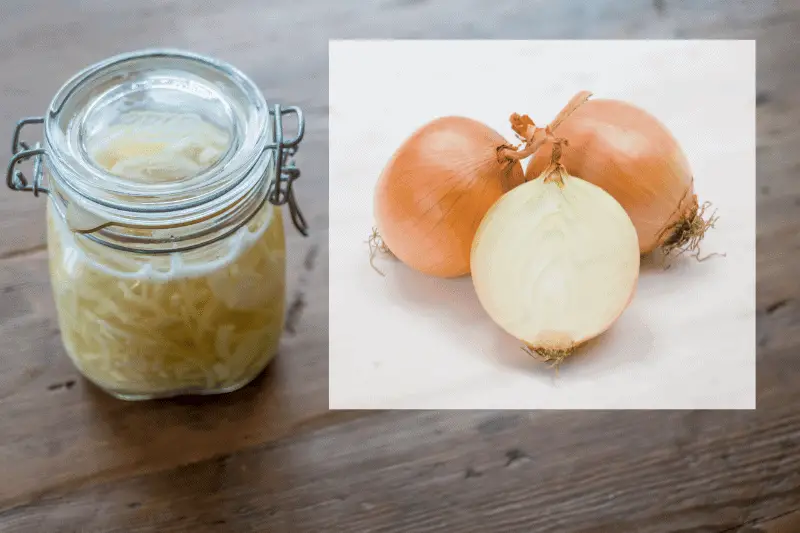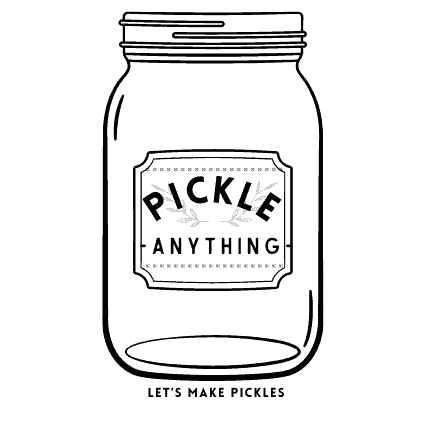If you don’t have any red onions on hand but still want to make some homemade pickles, yellow onions are a great substitute!
And super quick and easy too!
Can You Pickle Yellow Onions?

Yes, you can pickle yellow onions. Yellow onions offer a bolder flavor than white or red onions, and they can be pickled in a simple brine to create flavorful and crunchy pickles.
The key to using yellow onions is slicing them thinner than you would normally. Cut into matchstick-sized pieces.
You won’t get the nice color you would get from red onions, but the flavor should be bolder and more intense. If you’re looking to add a pop of color, consider adding some fresh herbs or spices, such as turmeric or chili powder to the pickling liquid.
Yellow Onions, Salt, Vinegar, Water, Mason Jars, or other containers with lids.
Pickling is a great way to preserve food, and one of the most popular items to pickle is onions.
Pickled onions are simple to make with just a few ingredients – yellow onions, salt, vinegar, water, mason jars, or other containers with lids.
To make pickled onions start by slicing the onion into thin rings then add them to the jar along with salt, vinegar, and water in equal parts (1/4 cup per each ingredient).
Cover tightly and let sit for 24 hours before consuming.
The result will be delicious tangy slices that can be enjoyed on sandwiches or salads!
Preparing the Onions:
Onions are a staple ingredient in many dishes, but they can be difficult to prepare.
To start, you must first remove the skin and top layer of the onion.
This is best done by cutting off both ends of the onion before peeling it away from its tough outer layers.
Once completed, you may proceed with slicing or chopping your onions as needed for your recipe.
Keep in mind that cutting an onion will release an acidic odor which can cause eye irritation and burn if not handled properly!
Wear protective eyewear while prepping onions to keep yourself safe and comfortable.
Washing, Peeling and Slicing
There are many ways to do this when it comes to washing, peeling, and slicing fruits and vegetables for a meal. The best way is to start by rinsing the produce under cold running water.
This helps remove any dirt or bacteria on the surface of the food item.
Once they have been washed thoroughly, you can move on to peeling with either a paring knife or vegetable peeler.
Finally, when you’re ready to cut your ingredients into slices or cubes, use a sharp knife and cutting board that has been wiped down with soap and warm water beforehand!
Pickling Brine Preparation:
- 1 cup of white vinegar
- ¾ cup of water
- 2 tablespoons of sugar
- 2 teaspoons of salt to a boil in a medium saucepan.
Once boiling, turn down the heat and let the mixture simmer until all the ingredients have dissolved (about 5 minutes).
Add any herbs or spices you’d like to use in the pickling liquid.
Remove from heat and allow the mixture to cool for 5 minutes before adding it to your onions.
Filling the Jars
If you are using a mason jar, make sure to leave some headspace at the top of the jar.
This is important to ensure that all the onions are submerged in the pickling liquid and not floating around.
Put the onions in the jar and I like to shake the jar so the onions separate a bit and settle.
Once all the onions are in the jar, pour the pickling liquid over making sure they are all covered.
Seal the lid tight and shake it to make sure all the onions are coated.
Place the jar in the refrigerator and allow it to sit for at least 4 hours (preferably overnight).
What variety of onions is best for pickling?
The best onion variety for pickling is the sweet or mild onion such as Vidalia, Walla Walla, or Maui onions.
These types of onions have a mild flavor that pairs well with pickling brines, herbs, and spices.
Their sweetness helps to balance out more tart flavors and their high moisture content allows them to absorb more seasonings.
Additionally, they are less likely to become tough during the pickling process.
Which vinegar is best for pickling?
The best vinegar for pickling is one that has a high acidity level, such as white wine vinegar or apple cider vinegar.
White wine vinegar has an acidic pH of about 2.4, making it ideal for pickle recipes with more delicate vegetables like cucumbers and peppers.
Apple cider vinegar has a slightly less acidic pH of 2.7 but is still suitable for pickling onions and other vegetables.
For pickles with bolder flavors, using balsamic or red wine vinegar may be preferred.
Ultimately, there are many types of vinegar suitable for pickling; the choice depends on the flavor desired in the final product.
